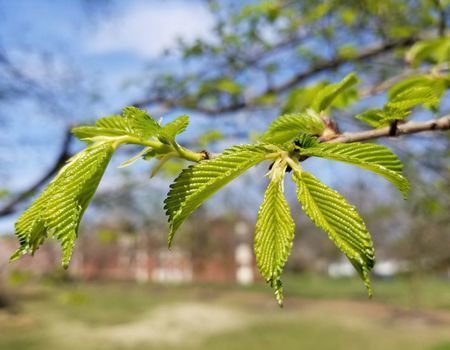Slippery Elm

Scientific Name: Ulmus rubra
Common Name: Slippery elm, red elm, gray elm, soft elm, moose elm, and Indian elm
Plant Family: Ulmaceae (Elm family)
Etymology: “Slippery” refers to its moist inner bark. The genus Ulmus is proto-European for “mountain elm,” and specific epithet rubra refers to the red color of the bark.
Parts Used: branches, bark, wood
Season: spring, summer, fall
Indigenous Uses
Native Americans quenched thirst by chewing the sweet, fibrous inner bark peeled from twigs and branches. As a potent yet gentle medicine, the inner bark of Ulmus rubra was used widely to poultice eyes, sores, burns, and wounds. Chewed or taken as a decoction, the bark soothed stomach and bowels, served as a mild laxative, supported women during pregnancy, and treated heartburn, dysentery, chronic bowel complaints, sore throats, and coughs. It also was used to treat quinsies (peritonsillar abscess), catarrhs, colds, and consumption. The inner bark decoction supported birthing mothers, and an inner bark infusion soothed diarrhea and was used as a laxative. Uses of the bark continue with craftwork: a floor matting when camping in snow; boiled to weave baskets, bedding, and mats; woven into frames for snowshoes and fishing nets. The bark was also used for canoes, and branches were used as the frame for horse saddles.
How to Harvest
During warm weather, prune large lower branches to remove sleeves of bark, which promotes speedy recovery of the tree as the wound heals over. Alternatively, the bark can be removed from mature tree trunks by pulling off 4-inch-wide strips. Limit harvests from a single tree to permit the bark to regrow. Harvest bark in the spring when the sap is running for the best quality, the inner bark becomes more astringent and less desirable in autumn. Chew the fresh or dried bast to release its healing mucilage.
To preserve, cut the bast into 6-inch strips and dry in the sun, flipping periodically over a few days, to prepare for long-term storage in sealed jars, away from light.
Contemporary Medicinal Uses
Modern herbalists use slippery elm to treat upset or inflamed stomach, colic, dysentery, stomach or duodenal ulcers, diverticulitis, inflammatory bowel disease, ulcerative colitis, sore throat, coughs, and bronchitis. It replenishes mucous membranes, absorbs and purges toxins, and nourishes immune mast cells.
A cold overnight infusion in water can be sipped for a mucilaginous healing beverage. Alternatively, grind the bark into a powder and dissolve in hot water for a tea, or create a thick nourishing gruel to support healing of sensitive individuals. A poultice can also be made from the powder for swollen glands, infections, splinters, eruptions, and wounds.

This project was made possible by a grant from Maryland Humanities, with funding received from the Maryland Historical Trust in the Maryland Department of Planning. Maryland Humanities’ Grants Program is also supported by the National Endowment for the Humanities and private funders. Any views, findings, conclusions, or recommendations expressed on this website do not necessarily represent those of Maryland Humanities, Maryland Historical Trust, Maryland Department of Planning, or National Endowment for the Humanities.

